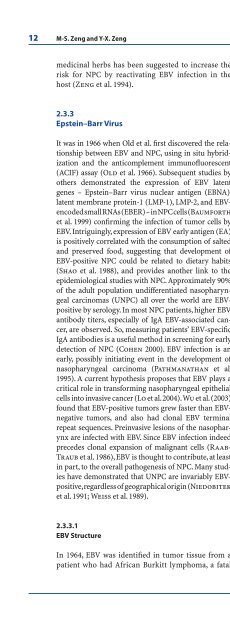Familial Nasopharyngeal Carcinoma 6
Familial Nasopharyngeal Carcinoma 6
Familial Nasopharyngeal Carcinoma 6
- No tags were found...
You also want an ePaper? Increase the reach of your titles
YUMPU automatically turns print PDFs into web optimized ePapers that Google loves.
12 M-S. Zeng and Y-X. Zengmedicinal herbs has been suggested to increase therisk for NPC by reactivating EBV infection in thehost (Zeng et al. 1994).2.3.3Epstein–Barr VirusIt was in 1966 when Old et al. first discovered the relationshipbetween EBV and NPC, using in situ hybridizationand the anticomplement immunofluorescent(ACIF) assay (Old et al. 1966). Subsequent studies byothers demonstrated the expression of EBV latentgenes – Epstein–Barr virus nuclear antigen (EBNA),latent membrane protein-1 (LMP-1), LMP-2, and EBVencodedsmall RNAs (EBER) – in NPC cells (Baumforthet al. 1999) confirming the infection of tumor cells byEBV. Intriguingly, expression of EBV early antigen (EA)is positively correlated with the consumption of saltedand preserved food, suggesting that development ofEBV-positive NPC could be related to dietary habits(Shao et al. 1988), and provides another link to theepidemiological studies with NPC. Approximately 90%of the adult population undifferentiated nasopharyngealcarcinomas (UNPC) all over the world are EBVpositiveby serology. In most NPC patients, higher EBVantibody titers, especially of IgA EBV-associated cancer,are observed. So, measuring patients’ EBV-specificIgA antibodies is a useful method in screening for earlydetection of NPC (Cohen 2000). EBV infection is anearly, possibly initiating event in the development ofnasopharyngeal carcinoma (Pathmanathan et al.1995). A current hypothesis proposes that EBV plays acritical role in transforming nasopharyngeal epithelialcells into invasive cancer (Lo et al. 2004). Wu et al. (2003)found that EBV-positive tumors grew faster than EBVnegativetumors, and also had clonal EBV terminalrepeat sequences. Preinvasive lesions of the nasopharynxare infected with EBV. Since EBV infection indeedprecedes clonal expansion of malignant cells (Raab-Traub et al. 1986), EBV is thought to contribute, at leastin part, to the overall pathogenesis of NPC. Many studieshave demonstrated that UNPC are invariably EBVpositive,regardless of geographical origin (Niedobiteket al. 1991; Weiss et al. 1989).2.3.3.1EBV StructureIn 1964, EBV was identified in tumor tissue from apatient who had African Burkitt lymphoma, a fatalmalignancy of the B lymphocyte (Epstein et al.1964). EBV is a g-herpes virus (Wan et al. 2004) presentin over 90% of adults worldwide. It is a memberof the Lymphocryptovirus genus – viruses that areclosely related members of herpesvirus family. TheEBV genome is large exceeding 172 kb pairs of lineardouble-stranded DNA, as in other herpesviruses, themolecule is divided into unique, internal repeat, andterminal repeat domains. EBV was the first herpesvirusto have its genome completely cloned andsequenced (Baer et al. 1984). During growth transformation,the virus does not replicate and produceprogeny virions, but rather is replicated by the hostDNA polymerase as an extra chromosomal episome(Raab-Traub 2002).2.3.3.2EBV Infection in NPCEBV was the first human virus identified to be associatedwith human cancers, including lymphomas aswell as epithelial tumors (Epstein et al. 1966). Theassociation between EBV infection and NPC is welldocumented and particularly close with EBV genomepresent in virtually all NPC cells. Primary EBV infectionnormally occurs in early childhood, is usuallyasymptomatic, and results in life-long virus persistence,but when exposure is delayed until adolescence,infection mononucleosis often ensues provoking aninfection during early adulthood. EBV has a strongtropism for human lymphocytes and for the epitheliumof the upper respiratory tract, where it canremain latent (Borza et al. 2002). This virus has beenassociated with different neoplastic diseases, like polyclonalB lymphoproliferation in immunosuppressedpatients, Burkitt lymphoma, or Hodgkin’s disease(Niedobitek et al. 1994). However, the tumor showingthe strongest worldwide association with EBV isnasopharyngeal carcinoma (Liebowitz 1994;Pathmanathan et al. 1995). Elevated titers of IgAantibody to EBV viral capsid antigen (VCA) are usuallyfound in patients with NPC. The rise in IgA titersto these antigens can be noticed before the developmentof UNPC and correlates with tumor burden,remission, and recurrence (Mazeron 1996; Zhenget al. 1994). Therefore, this method of measuringpatients’ EBV-specific IgA antibodies is useful inscreening for early detection of NPC (Cohen 2000).In almost all cases of EBV infection, the oropharynxis the primary site of infection, as well as the siteof viral replication. EBV infects primary resting B











